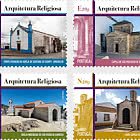Nine circular towers protect the high walls of Almourol Castle, one of the most notable medieval military monuments from the time of the Reconquista, built on the granite escarpment of a small island in the district of Santarém, today lending the surrounding landscape a scenic charm. The castle is known to exist as early as 1129, under the name Almorolan. However, the epigraph above the main doorway bears the inscription of the year 1171, referring to its rebuilding by the Order of the Knights Templar. The keep as the centre of the whole structure and the quadrangular arrangement of the spaces are features of Templar architecture in Portugal.
At one of the highest points on the north slope of the Serra de São Mamede, in the district of Portalegre, stands Marvão Castle, built in the 18th century as a way to strategically secure the defence of the border with Spain.
The “most unconquerable forti cation in the Kingdom” sits on an elevated rocky platform, accessible only to the east. It has an enormous cistern attributed to the 15th/16th centuries, when the town was at its demographic peak. An extraordinary point of refuge and surveillance, Marvão Castle re ects the development of military technology in its successive transformations.
The Fort of São Brás was erected in the 16th century for the defence of the port and anchorage of the capital of the island of São Miguel in the Azores. It is regarded as the most signi cant forti cation of its time and, at the same time, the most powerful of the city of Ponta Delgada. The archipelago was coveted by pirates and corsairs, attracted by the wealth carried by the ships that docked there on their way from Africa, India and Brazil. In 1585, the barrage of re from the fortress forced the withdrawal of two English warships that
had attacked a Spanish galleon. The fort became headquarters of the Azores Military Command from 1940.
Plans for the Fortress of São João Baptista, in Angra do Heroísmo, started after the conquest of Ilha Terceira by Castilian troops, and construction began in 1603. It originally took the name São Filipe, in tribute to King Filipe II of Spain. Designed to protect the city’s port and to quarter Spanish troops, over the centuries it has taken on other historically relevant roles. Today, it is the oldest quarters still billeting operational troops on Portugueseterritory.
In the historic centre of the city of Funchal, capital of the Autonomous Region of Madeira, is the Fortress of São Tiago, the building of which started in around 1614, during the Habsburg rule of Portugal, to defend the island. During the Napoleonic wars, the fortress quartered British troops and in the 20th century, it formed the barracks of the Mobile Artillery Battery, quarters of the Military Police and the Funchal Lancers Squadron. During the ood of 9 October 1803, it housed homeless families.
Also in the capital of the Madeira archipelago, but on Pico dos Frias, is the Fortress of São João Baptista, popularly known as Fortaleza do Pico or Pico-Rádio, due to the fact that the Navy’s Communications Centre was once installed there. At the time it was built, in the second half of the 17th century, the fortress functioned as a storehouse for gunpowder destined for the island’s forts and towers. Its outline in the landscape of Funchal has inspired artists from all latitudes to depict the forti cation in countless works of painting, engraving, drawing and photography.














































